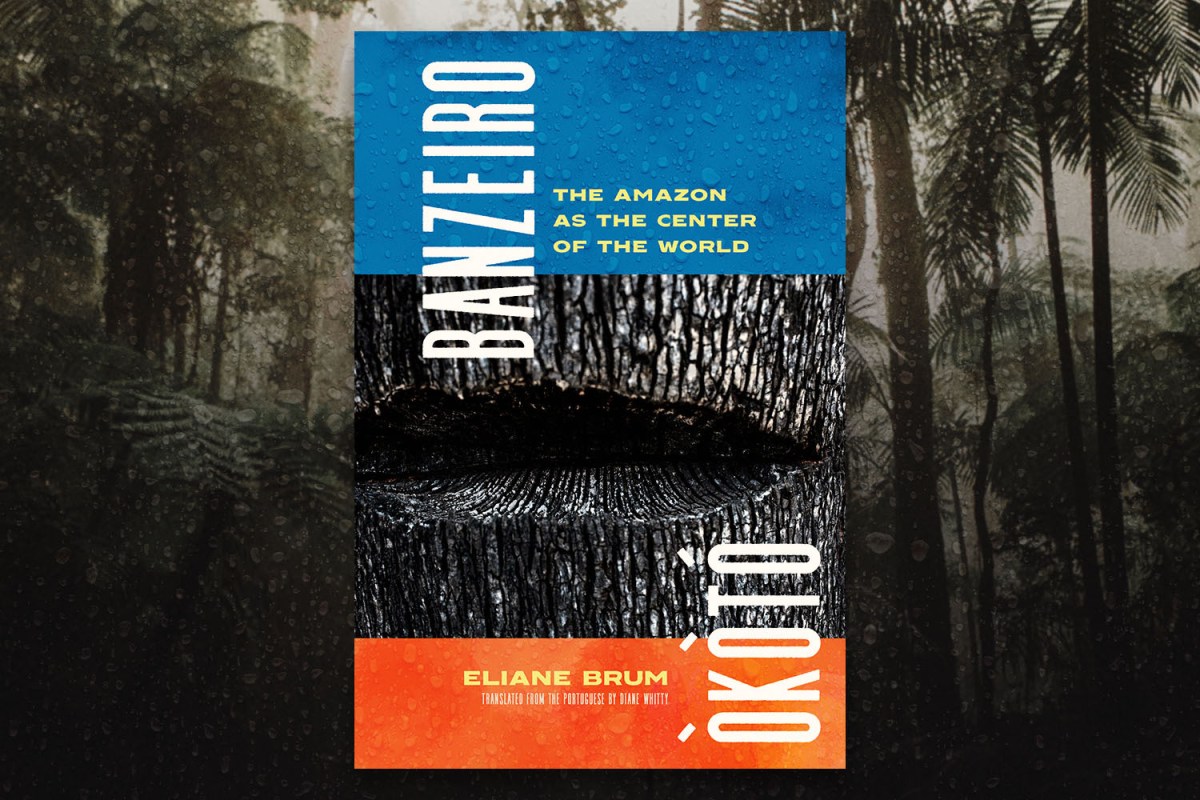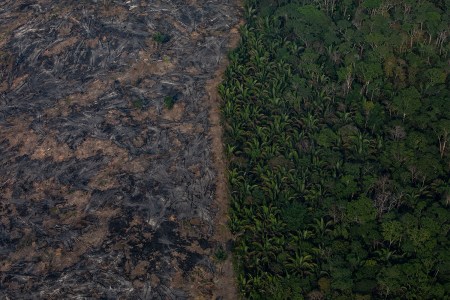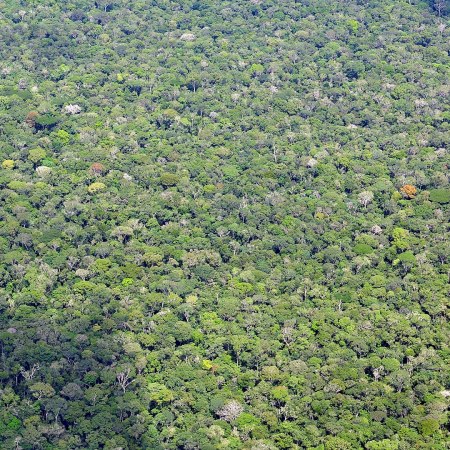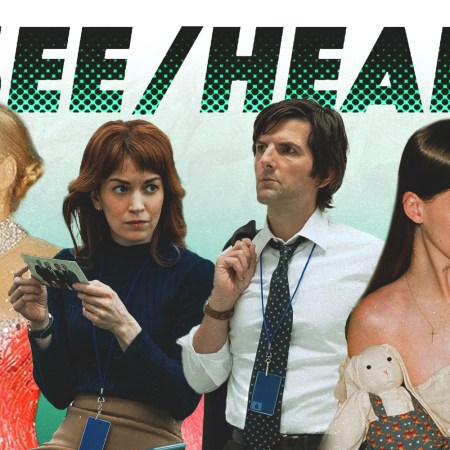There isn’t just one good reason to preserve the Amazon rainforest — there are several, from its effect on the global climate to the fact that numerous Indigenous groups call it home. In her new book Banzeiro Òkòtó: The Amazon as the Center of the World, Brazilian journalist Eliane Brum (along with translator Diane Whitty) chronicle the activists, thinkers and everyday people who are committed to a better future for the Amazon.
In this excerpt, Brum discusses the controversy over the Belo Monte dam, a massive piece of infrastructure that faced several legal challenges over its effect on the rainforest. The excerpt zeroes in on some of the loudest voices raising concerns about the project, including agronomist Antonio Donato Nobre. Brum’s book explores the state of the rainforest from several angles, chronicling its importance and the scale of the challenge for those involved in protecting it.
Flying Rivers
Belo Monte is a monstrous mountain of horrors. It’s also an assembly line for the explicit conversion of forestpeoples into the poor. And a paradigm. There are, however, many other ways to achieve this conversion, some much more sophisticated and harder to combat. It is vital to understand that this conversion is strategic to destroying the Amazon. The forces of destruction know this and are working at an accelerated pace to produce poor people. Blocking this perverse process is imperative to keeping the Amazon from reaching the point of no return.
Yet many of those who support the protection of the forestpeoples do not understand this unavoidable issue. The only effective way to reforest the Amazon is to reforest the forestpeoples who were or are in the process of being converted into the poor. If not for humanitarian reasons, then because they are the frontline in the great battle of our time, that of the climate emergency and mass extinction. Unless the forestpeoples are forest, there is no possible way the world’s largest tropical forest can play its role in regulating the climate through its continuous gesture of launching “flying rivers” into the world’s skies.
In 2014, the Brazilian researcher Antonio Nobre, one of the most inspiring Earth scientists on this planet, released a report in which he synthesized more than two hundred scientific papers: “The Future Climate of Amazonia.” Translated into various languages, it was a landmark study. Antonio is the fifth of six siblings, four of whom are well-known scientists working to defend the Amazon, but with different approaches and ideas about how to protect the world’s biggest tropical rainforest.
Among Brazilian scientists, Antonio has gone the farthest in absorbing an understanding of the forestpeoples, and this is one reason the language of his scientific texts is interlaced with the poetry he feels in nature. Because of this, those who espouse the hegemonic, obtuse view of what a scientific text should be—generally boring, poorly written, and inaccessible to nonscientists—have raised questions about his work. Scientists who produce readable, fluent, appealing texts are only tolerated in so-called science communication books, which are thought of as science for “regular people.” Academia, as we know, is a bloody battlefield that could inspire thrillers as entangled as a Cold War spy novel.
In his poetic-scientific report, Antonio Nobre stated that the Amazon needs a “war effort.” The scientist denounced the economic forces that were then gestating Jair Bolsonaro and the era looming around the corner. But few were willing to listen to him. Given the many catastrophes triggered in more recent years, especially the fireworks in the forest sponsored by Bolsonarism in 2019, what Nobre was saying seems obvious today, even a given. But that wasn’t the world in 2014, nor Brazil in 2014, when the construction of hydro dams in the Amazon was a project not only used by the Workers’ Party (PT) to leverage the reelection of Dilma Rousseff for a second term but also used by Brazil’s historically extractivist and colonialist elites and also by the liberal press, who did not hide its opinion that Belo Monte was—as so often called—a “magnificent engineering project” and that agrobusiness was an example of national “might.” The “free market” was still the oracle, not science, much less forestpeoples.
At that point in time, critics of agrobusiness expansion in the Amazon or in the Cerrado, another hard-hit ecosystem, were scarce, other than social-environmental organizations, and there were almost no barriers to it. Dissonant voices were cowardly attacked by the right, center, and also the left with ties to the PT. Belo Monte, like the Jirau, Santo Antônio, and Teles Pires dams, was built by violating nature and the rights of local populations, making them part of a thorny chapter in the dispute for power. These dams are a crime perpetrated by the alliance in power, led by the PT in alignment with large contractors and various other segments of the country’s political and economic elites. Since the message was inconvenient, the outcry had to be silenced.
For much of the press, Belo Monte only became something to be denounced once Operation Carwash had shown what the forestpeoples, social movement leaders, and scientists had said well before the power plant dammed up the Xingu: that Belo Monte had been designed to generate more bribes than energy. At that point, given the newfound interest in removing the PT from power, Belo Monte no longer represented a magnificent engineering project but instead more proof of the incumbent party’s corruption. While the violation of people’s rights and the rights of nature had been denounced in more than twenty suits filed with the Public Prosecutor’s Office, neither the right nor the majority portion of the left had ever assigned this any importance. It was only after the first rumblings about Dilma Rousseff’s possible impeachment that the press made it a regular practice—one that was both stimulated and stimulating—to blast Belo Monte. The same press that had either said nothing about the project, failed to investigate it, or even defended it now began denouncing what everybody already knew, as if it had never done precisely the opposite.
As a paradigmatic example of an Amazon-destroying project—the serpent’s egg where an entire organic structure decries the corrupt, predatory colonialist worldview—Belo Monte expresses the context of those thirteen years of the PT in power, from the perspective of the forest. The Amazon was treated like a periphery, a source of raw materials for export, and, at that moment, also as a source of hydroelectric power. The extractivist perspective was embraced by a left that had been built around unions, with urban roots and imbedded in industrialization, the left that deems the factory a symbol of progress. The extractivist perspective was also shared by those who belonged to what is conventionally (and, in my opinion, erroneously) called Brazil’s “new middle class.”
When Antonio Nobre released his report in 2014, only limited groups of society were interested in the Amazon and climate, topics that were only tangentially a part of national debate back then. The scientist was attacked by part of the Brazilian news media, who distorted what he wrote. It’s reasonable to assume that some were driven by pressure from advertisers, who saw their interests in the Amazon taken to task. Antonio was also targeted by his peers, although generally behind the scenes. There were few frontal attacks to a report that valorized the best of science produced on the climate and the Amazon by the best of scientists, but there was much backstage whispering into opinion makers’ ears with the goal of undermining his credibility. Nor was Antonio defended by his peers, many of whom had seen their work generously cited, analyzed, and popularized in his report. Envy and cowardice are entwined sentiments. It is never easy to deliver bad news that powerful sectors don’t want announced to the public. Antonio ended up alone. Over the years, his active role, grounded in his understanding of himself as a scientist with public responsibility, has literally cost him pieces of his heart.
As for me, someone who had been traveling to the Amazon as a journalist since 1998 and closely following the wreckage caused by Belo Monte, the report woke me to the fact that it wasn’t enough to denounce violence against the Xingu. I had to engage in the “war effort.” It was through Antonio Nobre’s words and his exhaustive endeavor to investigate everything of relevance that had been produced on the Amazon both inside and outside Brazil that I came to understand this as the great battle of my time.
Shortly after the report was released, Jan Rocha, the most Brazilian Brit I know, summoned me to her home. Jan was already a veteran of this war, having covered the Amazon ever since the destruction wrought by the business-military dictatorship’s various government administrations in the 1970s, when she had realized that fighting for the Amazon and its peoples also obliged her to fight for those who had been disappeared, tortured, and imprisoned for political reasons by South American dictatorships. Jan was seventy-something but still had more energy than most of the young reporters I knew. A pair of probing eyes, a razor tongue, and seemingly perpetual bangs—these were the features an artist would use to draw her caricature. With Antonio Nobre’s report ringing in her mind and her pupils lit with a spark, Jan received me in her home in São Paulo so we could sketch out a plan to awaken different spheres of Brazilian society and convince them to join the fight for the Amazon.
Jan and I knocked on a number of doors, sometimes with moderate success, mostly with none. Blatantly naïve, we presented our “case” in a letter entitled “Carta para viver” (Letter for living). We opened with a quote from the U.S. philosopher Donna Haraway. I had heard Haraway speak at “The Thousand Names of Gaia: From the Anthropocene to the Age of the Earth,” a colloquium held in Rio de Janeiro in 2014, organized by the French philosopher Bruno Latour and the Brazilian thinkers Eduardo Viveiros de Castro and Déborah Danowski. When the seminar ended, I did a two-day-long interview with Eduardo and Déborah. Published in my column for El País, the piece resonated with intellectuals, who seemed to be waking up to the topic right then.
“The Thousand Names of Gaia” had my head swirling. At that point in time, I was unfamiliar with the Gaia Hypothesis proposed by James Lovelock, one of the most famous British scientists alive and the closest to an inventor of fiction that we can find in the real world. In the late 1970s, Lovelock ignited passions and hatred, a cult following and mockery, when he introduced the idea that the planet is a dynamic, self-regulating community of intensely interacting organisms, a theory he baptized with a name borrowed from Greek mythology. For a more multicultural reader, it is quite evident that his thesis echoes centuries-old knowledge found in the cosmogony of most Indigenous peoples, but Lovelock acquired this knowledge along the course of a very specific journey and in his own terms. Language, after all, is not clothing but a way of inhabiting your own body. In an interview with the Guardian, philosopher Bruno Latour said that the electron capture detector, one of Lovelock’s creations, revealed truths about life on the planet much as Galileo’s telescope revealed truths about the Universe.
At the historic seminar in Rio de Janeiro in 2014, the reference to Lovelock’s Gaia theory was meant to evoke the Earth’s potential for creation and destruction. The event was both a warning and an irresistible invitation to ponder human experience through the effects caused by a species that had converted itself into a force of destruction capable of altering the planet’s morphology.
The Amazon Rainforest Is Still in Crisis, The Viral Videos Have Just Stopped
Two years after wildfires captured the attention of the world, systematic deforestation is worse than everYears later, in 2020, the banzeiro once again flung me into its implacable whirling, and I found myself having lunch at a typical British cottage on the banks of the Channel. Seated far enough away to comply with pandemic-imposed physical distancing requirements, I was talking with James Lovelock, who became Jim, and his wife Sandy, an adorable American from Florida. At one hundred and one years old, Jim was almost as active as ever, working on a book, walking two kilometers a day, and with a mind as sharp as his tongue. My companion had indoctrinated me exhaustively about controlling my equally sharp tongue so I wouldn’t set off any political discussion that might rouse tensions and sour the delicious fish pie, since Jim is politically conservative.
Minutes before, with the generosity of someone looking for a common topic to discuss with a stranger, Sandy had asked me why poor women in Brazil had so many children. She had read a few chapters of the book I’d published one year earlier in the United States and Great Britain, a collection of news stories, and it had left her depressed, frankly. Jim and Sandy are a charming couple, brimming with the savory stories of those who witnessed the twentieth century from the front row, and I believe that after the age of one hundred, you’ve won the right to say whatever you want.
In 2014, however, another thinker had captured my attention. A quotation from a video interview with Donna Haraway became my mantra. She lent words to the way I’d been living in recent years, the way, I suspect, I’ll live forever. Here is how I remember her words: “We must live in terror and joy.” Nothing about the experience of living at the intersection of the climate collapse and the sixth mass extinction seems more exact to me. This perception was to prepare me for life in the time of pandemics.
This article was featured in the InsideHook newsletter. Sign up now.
























